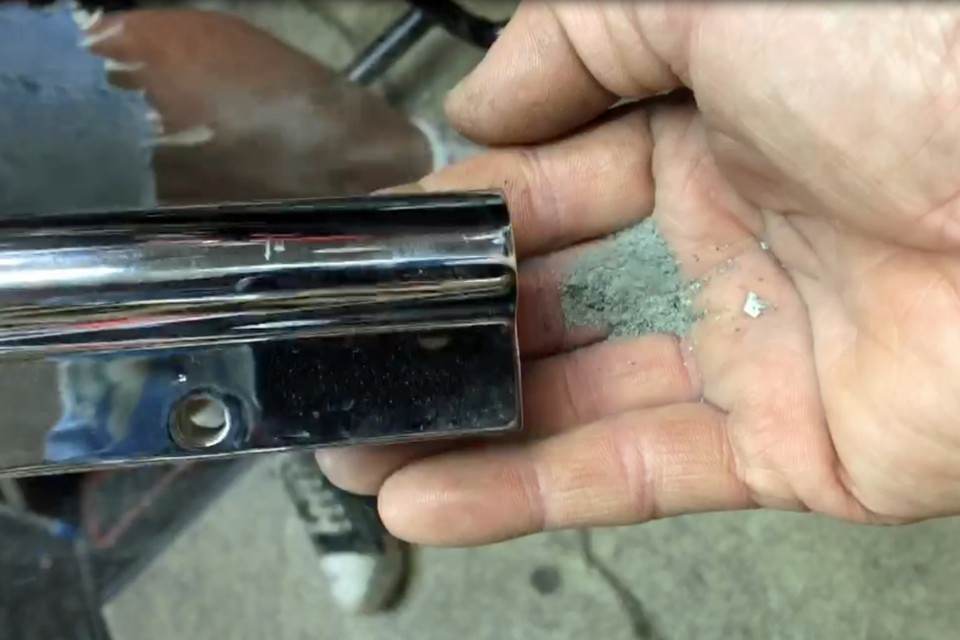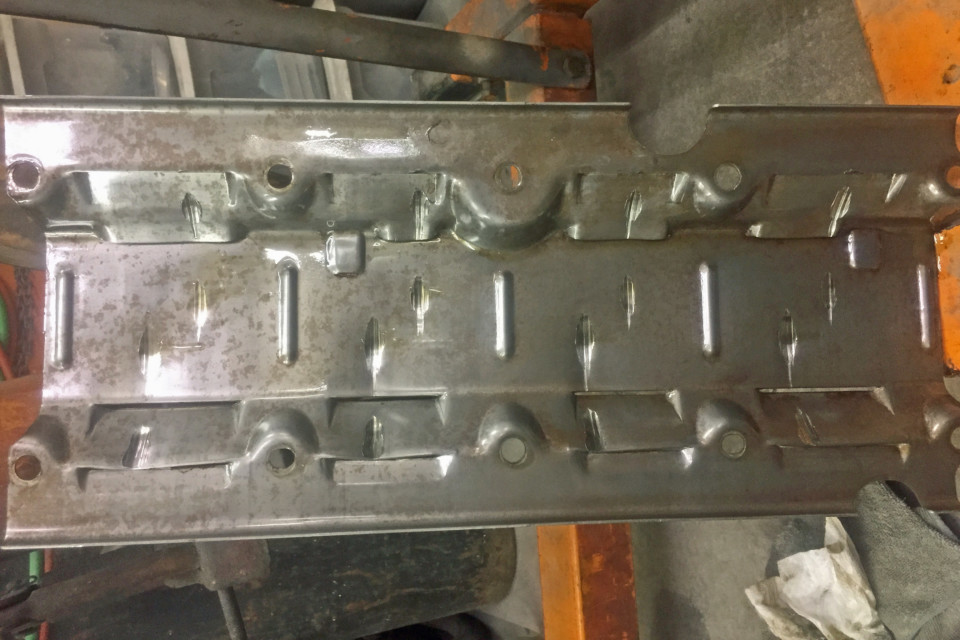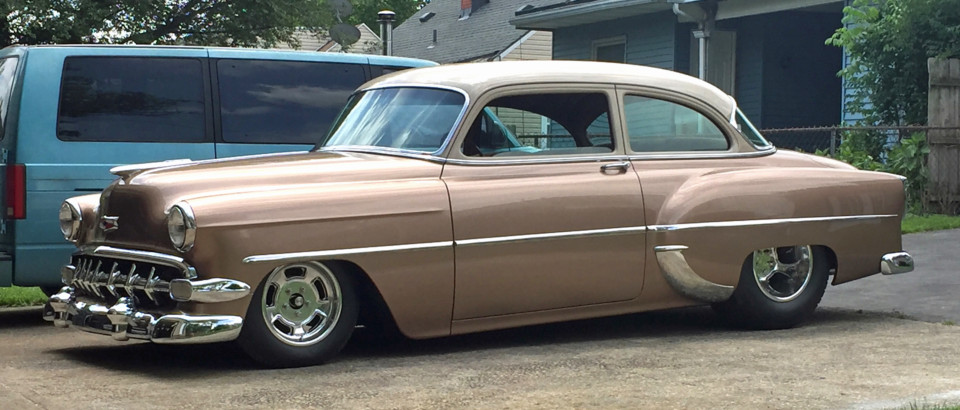My friend Scott Sullivan has been building cars forever. Our first big story together was back when I was editor of Hot Rod and we drove his “Cheese Whiz” ’55 Chevy from his home in Dayton, Ohio out to my home in Los Angeles. We chronicled that adventure in the magazine back in 1988 and looking back it was a crazy trip with all kinds of fun mini-disasters.
Since then Scott has built many cars and motorcycles and painted dozens more. His latest exploit is a 427 LS-powered ’54 Chevy with a GM T56 six-speed manual. The car has taken a long time to build because he is so meticulous. A couple of years ago it suffered an accident while being transported in a covered trailer that really bashed it up. The body was battered but Scott fixed it and repainted almost the entire car. For the last month or so, he’s been struggling to keep the car running and has faced an almost continual struggle. A friend told him he thinks the car is cursed.
Most of the troubles started once the car was running. At first, there was a power steering hydraulic failure – turned out that the outlet from the power steering reservoir to the pump was restricted. Then he discovered several minor leaks that caused the system to not build pressure.
Once those were fixed, the car initially ran fine and then progressively deteriorated. Scott’s friend Marty Miller has been helping almost every day to figure out the car’s problems
Marty has some experience with the Holley HP fuel injection system and at first, the indications were that the issues originated from with the EFI. This evolved into perhaps a couple dozen phone calls, texts, and emails between Scott and me concerning possible solutions.
At first, they thought the fuel delivery system had failed, but later discovered that Scott had wired the fuel level indicator backwards, so when it read full the tank was really empty. There was also some question about whether the fuel pump size was sufficient, so Scott bought a larger pump and installed it in the tank and added fuel. The engine ran but clearly not well.
This evolved into a long discussion where Marty believed the fuel delivery system was at fault. Scott had built an AN-6 hard-line system that placed the fuel pressure regulator downstream of the fuel rail, which is actually an ideal way to build a fuel system. There was also some question about whether he should hook up the vacuum line to the fitting on the pressure regulator. We determined that he should connect the fitting to manifold vacuum so as to maintain the same fuel pressure differential at idle. This fitting is also used for boost-referencing fuel pressure when using a supercharger or turbocharger.
The next misdirection was when Scott mentioned that he had tied the MAP sensor into a vacuum line connected to a vacuum reservoir for his power brakes. That didn’t seem like a good idea, so he re-routed the lines and separated them but the engine still ran poorly. The illness had continued for a couple of weeks at this point, and it still wasn’t resolved. Scott just wanted to get this car running for the big Goodguys show in Columbus, Ohio in July. Time was running short, tempers were equally abrupt and most importantly of all, the car still did not run. Unlike those fake “reality” car shows that are continually under “pressure” from fabricated deadlines – this was real and the anxiety was building.
Looking closer, Marty uncovered a small but significant clue. Once the ignition power was turned off, the fuel pressure would quickly plummet. At first we thought the pressure regulator was bad, but Marty yanked a couple of fuel injectors and jury-rigged a quick pressure test to discover the injectors leaked when fuel pressure was applied. This explained why the engine was excessively rich at idle and yet would hesitate badly with even light acceleration.
Others continued to blame the electronic side, but this discovery looked promising. The problem was that there was no place, locally, to get the injectors cleaned quickly so I shipped a new set of injectors I wasn’t using and Scott had them the next morning.
In the meantime, he sent me a photo of the fuel rails that a year before had been chromed. The photo shows a pile of debris that came out of the fuel rail when they ran a brush through the inside. Scott didn’t inspect the insides before installing them because he assumed they cleaned them before delivery.

This is a shot of some of the crud that came out of that fuel rail. That’s what you get for assuming that someone else took the time to clean them.
This was actually good news. We figured this would solve the problem. Marty could load the base program back into the ECU (deleting all the tuning from the attempt to cure the too-fat idle) and the engine should run like a champ. They did that, the engine immediately fired and idled nicely but immediately exhibited a rather obnoxious knock that sounded just like a spun rod bearing! A close inspection of the oil revealed shiny bits of metal.
Ughhhh… Of course, everybody assumed the worst but it was clear the engine had to come out in order to identify the problem. Scott spent three days carefully pulling the engine out of the car and then yanked the pan. He had purchased this as a crate engine that came without the oil pan and windage tray, but they were supplied. Since this was an LS stroker package, Scott and a friend installed the windage tray and pan when the engine was new but didn’t check the clearance to the tray.
Once the pan was removed, it was instantly obvious that the connecting rods were hitting the windage tray and that’s what had caused the noise – sounding just like a rod knock.
Again, this was good news because it could be easily repaired. They did that and cleaned out as much of the old oil as possible (Scott had actually changed the oil twice already) and reassembled the engine.
As I write this, he’s stuffing the engine back in the car and has discovered some other errors with the clutch that will have to be repaired at a later date. For now, it will only have to work long enough to survive the show.
Looking back it might seem all the difficulties would be comical if they weren’t so disheartening. The biggest thing we’ve learned is that it seemed everybody wanted to blame the electronic side when it turned out to be a mechanical issue. We’ve learned that lesson back when EFI was new and nobody trusted it. Human nature is to mistrust the things you don’t understand. That’s the lesson here – Scott worked through all the details and paid attention to the clues the car gave him instead of quickly blaming the component you understand the least. The idea is to follow the clues that the car gives you.

This is the damaged windage tray that sounded just like a rod knock as the rods smacked into it at the bottom of their stroke.
This is much like what a detective or a forensic scientist might do – except instead of hunting criminals, we’re looking to identify problems with engines. We thought there were at least five other things that might have caused this problem, but ultimately, it came down to dirt in the fuel rails. The issue with the windage tray we chalked up to Scott not knowing he was supposed to check clearance, and never turned the engine over by hand before he installed the engine. If he had, he would have felt or heard the contact and fixed the problem.
It looks now like Scott will make the show although he’ll probably have to forgo sleep to get the car finished. It’s amazing the crisis we endure just to have a little fun with our cars. My guess is that just about every hot-rodder who has ever messed with cars has a similar war story – some likely a lot worse than Scott’s ’54 adventure. We’ve lived that pain but came out on the good side with a happy ending.




